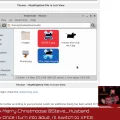Ubuntu 18.04.2 is ready for public consumption, Kali goes Bananas, System76 refreshes their Serval line, and PulseEffects 4.5 switches things up.
Special thanks to:
MacGeek (exec prod)
Haplo (exec prod)
Subscribe:
Listen:
Download:
Subscribe Spotify | Pandora | TuneIn | RSS | More
Colour key – Venn Jill Pedro
- Ubuntu 18.04.2 has been released with several important upgrades.
- Ubuntu 18.04.2 LTS ships with Ubuntu 18.10 Cosmic Cuttlefish graphics stack and the 4.18 Linux kernel, so we will get a new kernel and updated Xserver, Wayland and Mesa drivers.
- Ten year support cycle for Ubuntu 18.04, till 2028!
- Like we talked about last week, it was postponed a week due to a boot bug.
- This of course also applies to all the distros which use the LTS as a base.
- So if you’re running KDE Neon and want that newer kernel or mesa without resorting to PPAs, now you can haz.
- “All these have already been battle-tested in Ubuntu 18.10”
- I would argue this.
- Metasploit 5.0 is a massive update that includes database and automation APIs, new evasion capabilities, and usability improvements throughout.
- 2019.1 also includes updated packages for theHarvester, DBeaver.
- here are no longer separate Raspberry Pi images for users with TFT LCDs because reasons.
- Banana Pi and Banana Pro can now enjoy 4.19 goodness.
- Metasploit hasn’t had a major release since 2011.
- …hasn’t seen a major release since 2011.*
- This is just the major version number bump.
- In fact, if you install Metasploit from your distro repo, you’ll see an update for it daily.
- I kinda wanna look at that 17.3” panel running at 144Hz.
- Pricing starts at a “modest” $2’000!
- As someone who carries around a portable workstation, an Asus ROG 17.3 inch laptop, or what I like to call my beast, the Servel would be good for me!
- I use it for my animation work and for remote broadcasts on LGC.
- AMD better be taking notes. <-
- A little bit of code to introduce the concept of different memory regions, and a simple buddy allocator to manage them.
- It’s going to be interesting to see what comes from a ground-up discrete GPU implementation.
- Intel understands where the money is, in calculating big data and rendering in Linux.
- Better and more efficient memory calculation is the future of GPUs, just as multicore processing was for CPUs.
- We’ve mentioned the Academy Software Foundation before.
- OpenColorIO has been free to the public but now the ownership has moved to the ASF.
- Used to create movies like “Spider-Man: Into the Spider-Verse,” “Hotel Transylvania 3,” “Alice in Wonderland” and “Cloudy with a Chance of Meatballs” to the open source community.
- A color management framework for visual effects and animation.
- OpenColorIO is natively supported in Blender.
- OpenEXR is another project due up on the list.
- This is exactly why the ASWF was formed, to help unify, advance and help with software licensing for open source software in the TV/film industry.
- OpenColorIO is the animation and visual effects equivalent to the Adobe and the Pantone color management systems for digital photography, printing, paints etc.
- Supports all the popular Foundry software used in the industry, including Nuke, Modo, Katana, and Mari animation and visual effects software. Many of which I use and teach.
- All the Foundry animation software, and most of the other industry standards used in the film industry is run and rendered in CentOS/RHEL 6 Linux! Many now support Ubuntu as well.
- I like this trend! More of this please!
- Almost a year ago we talked about Pulse effects
- Now it comes back with automatic sink detection and it applies the effects you had previously set for it.
- A new graphics equalizer with options to show/hide bars borders in the spectrum and to change their line widths, as well as a switch to enable/disable linear gradient.
- Limiter, compressor, reverberation, equalizer and auto volume effects for Pulseaudio applications.
- It’s like a stripped down set of Calf Studio Plugins for pulse without the hassle of install Jack.
- For those of you who consider Slackware the new kid.
- Yggdrasil, basically implementing the Ubuntu and WINE philosophies before either of these were a thing.
- These are the earliest Linux distros, the one’s who started it all, before our mainstream distros we all know and love came to being.
- Starting back in 1992, the first known distro-like tools to get access to Linux were released by HJ Lu on two 5.25” floppy disks.
- HJ Lu, or Linux 0.12, consisted of a “boot” disk and a “root” disk.
- To install it on a hard drive you had to edit the master boot record with a hex editor.
- TAMU Linux was the first Linux distribution to include the X Window System, instead of text based, and was developed in May 1992 by the Texas A&M Unix & Linux Users Group.
- Still have my copy of TAMU Linux on floppies that I downloaded from my brothers BBS. Lots of the early Linux distros could be found on BBSs, including LInus Torvald’s first prototypes of LInux.
Slice of Pi
- You don’t necessarily buy Pi’s for the desktop experience.
- And you certainly don’t get a Pi to run Windows.
- This is just more evidence to that.
- Not overclocking your Pi also has the benefit of it living longer.
- Do you want your RasPi B+ to catch on fire? ;-)
- $35 devices, melt them.
Feedback












